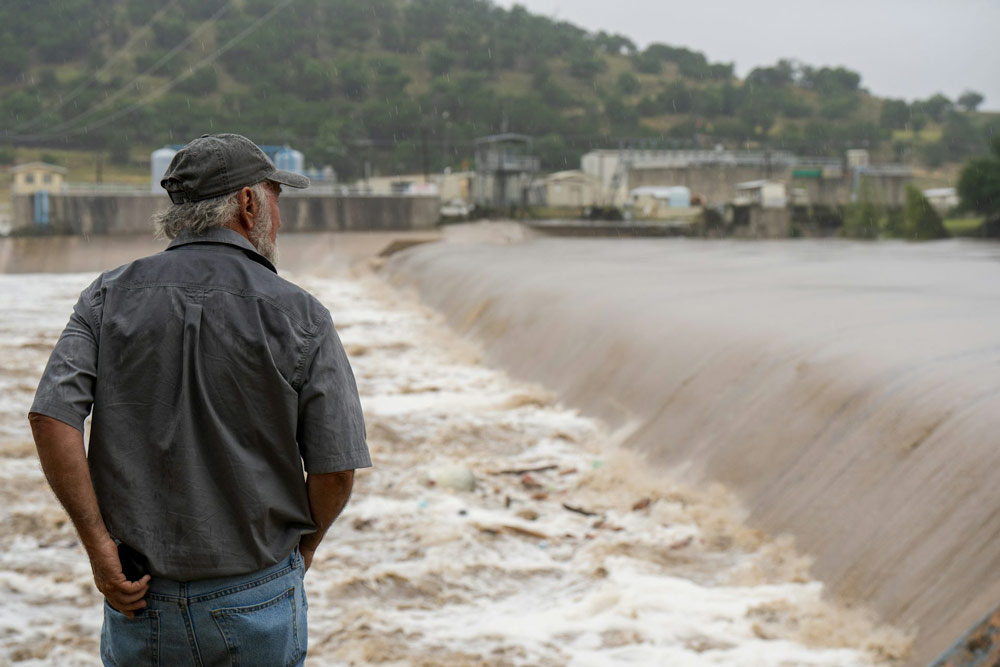
By Hatim Sharif
Texas Hill Country is known for its landscapes, where shallow rivers wind among hills and through rugged valleys. That geography also makes it one of the deadliest places in the U.S. for flash flooding.
In the early hours of July 4, 2025, a flash flood swept through an area of Hill Country dotted with summer camps and small towns about 70 miles northwest of San Antonio. At least 75 people died in Kerr County, and 10 girls from one camp were still unaccounted for, officials said on July 7. At least 19 deaths were reported in other counties.
The flooding began with a heavy downpour that sent water sheeting off the hillsides and into creeks. The creeks poured into the Guadalupe River.
A river gauge at Hunt, Texas, near the camp, showed how quickly the river flooded: Around 3 a.m. on July 4, the Guadalupe River was rising about 1 foot every 5 minutes at the gauge, National Weather Service data shows. By 4:30 a.m., it had risen more than 20 feet. As the water moved downstream, it reached Kerrville, where the river rose even faster.
Flood expert Hatim Sharif, a hydrologist and civil engineer at the University of Texas at San Antonio, explains what makes this part of the country, known as Flash Flood Alley, so dangerous.
What makes Hill Country so prone to flooding?
Texas as a whole leads the nation in flood deaths, and by a wide margin. A colleague and I analyzed data from 1959 to 2019 and found 1,069 people had died in flooding in Texas over those six decades. The next highest total was in Louisiana, with 693.
Many of those flood deaths have been in Hill County. It’s part of an area known as Flash Flood Alley, a crescent of land that curves from near Dallas down to San Antonio and then westward.
The hills are steep, and the water moves quickly when it floods. This is a semi-arid area with soils that don’t soak up much water, so the water sheets off quickly and the shallow creeks can rise fast.
When those creeks converge on a river, they can create a surge of water that wipes out homes and washes away cars and, unfortunately, anyone in its path.
Hill Country has seen some devastating flash floods. In 1987, heavy rain in western Kerr County quickly flooded the Guadalupe River, triggering a flash flood similar to the one in 2025. Ten teenagers being evacuated from a camp died in the rushing water.
San Antonio, at the eastern edge of Hill Country, was hit with a flash flood on June 12, 2025, that killed 13 people whose cars were swept away by high water from a fast-flooding creek near an interstate ramp in the early morning.
Why does the region get such strong downpours?
One reason Hill Country gets powerful downpours is the Balcones Escarpment.
The escarpment is a line of cliffs and steep hills created by a geologic fault. When warm air from the Gulf rushes up the escarpment, it condenses and can dump a lot of moisture. That water flows down the hills quickly, from many different directions, filling streams and rivers below.
As temperature rise, the warmer atmosphere can hold more moisture, increasing the downpour and flood risk.
The same effect can contribute to flash flooding in San Antonio, where the large amount of paved land and lack of updated drainage to control runoff adds to the risk.
What can be done to improve flash flood safety?
First, it’s important for people to understand why flash flooding happens and just how fast the water can rise and flow. In many arid areas, dry or shallow creeks can quickly fill up with fast-moving water and become deadly. So people should be aware of the risks and pay attention to the weather.
Improving flood forecasting, with more detailed models of the physics and water velocity at different locations, can also help.
Probabilistic forecasting, for example, can provide a range of rainfall scenarios, enabling authorities to prepare for worst-case scenarios. A scientific framework linking rainfall forecasts to the local impacts, such as streamflow, flood depth and water velocity, could also help decision-makers implement timely evacuations or road closures.
Education is particularly essential for drivers. One to two feet of moving water can wash away a car. People may think their trucks and SUVs can go through anything, but fast-moving water can flip a truck and carry it away.
Officials can also do more to barricade roads when the flood risk is high to prevent people from driving into harm’s way. We found that 58% of the flood deaths in Texas over the past six decades involved vehicles. The storm on June 12 in San Antonio was an example. It was early morning, and drivers had poor visibility. The cars were hit by fast-rising floodwater from an adjacent creek.
![]()
Hatim Sharif is Professor of Civil and Environmental Engineering at the University of Texas at San Antonio.




























Al says
Finally an informative article instead of the normal vitriol. The weather in that part of Texas is wild. I owned a farm in Erath County during the 70’s and it would go from 105 in the summer to -5 in the winter. We’d get 40 days of no rain then a week of heavy downpours. There are places with bridges 25 ft above a little creek and they get washed over from time to time.
Let’s hope they recover and survive their loses.
Skibum says
Camp Mystic’s location adjacent to a bend in the river puts it in extreme danger of being inundated by a large flash flood, so it is curious why the folks who established that camp for children made the decision to site it there in the first place knowing the danger that flash floods present to life and limb in that part of Texas. I understand that it has been there for decades, but as climate change has exacerbated the potential for natural disasters such as what occurred over the July 4th weekend, I wonder why more safety measures were not put in place to warn residents and visitors in that entire area of the impending danger.
I’m not placing blame by any means, but since this flash flood happened early in the AM when people were sleeping, the only way they could have known about the danger in time for them to evacuate would have been from an early warning system such as sirens strategically placed along sections of the river when a known flood emergency exists.
I don’t know if it is reasonable to further dredge that river to deepen the channel of water, or to build protective earthen mounds along the river bank near nearby, low lying buildings such as where the camp was located, but surely, knowing the potential for disaster one would think something more should have been done before having such a huge loss of life starts this conversation with local and state officials. I hope this tragedy puts the extreme danger of flash flooding in the Texas hill country in proper perspective so adequate safeguards can be put in place to prevent such preventable disasters in the future.